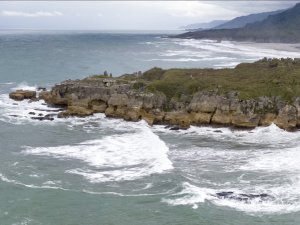Respiratory physician Lutz Beckert considers chronic obstructive pulmonary disease management, including the prevention of COPD, the importance of smoking cessation and pulmonary rehabilitation, and the lifesaving potential of addressing treatable traits. He also discusses the logic of inhaler therapy, moving from single therapy to dual and triple therapy when indicated, as well as other aspects of management
Tourist town practices lose patients to telehealth GPs
Tourist town practices lose patients to telehealth GPs

ESSENTIALS
- Queenstown and Wānaka medical practices report losing potential patients to government-funded Ka Ora telehealth GPs, financially impacting the region’s after-hours services.
- The practices claim local care is being undermined by Ka Ora’s triage system, which directs some patients, including non-urgent cases, to telehealth GPs rather than local clinicians.
- The practices have raised their concerns with Ka Ora and Te Whatu Ora.
Queenstown and Wānaka practices report losing potential patients to government-funded telehealth GPs when their own after-hours services are available.
WellSouth PHO chief executive Andrew Swanson-Dobbs raised the issue in a recent New Zealand Doctor Rata Aotearoa opinion piece (online, 29 August and in print 11 September), saying telehealth providers funded by Te Whatu Ora had “undermined” existing services “clinically and financially”.
“Practices that can offer after-hours care are now competing with telehealth,” Mr Swanson-Dobbs wrote.
Wānaka’s Aspiring Medical Centre and Wanaka Medical Centre provide weekend clinics and weekday after-hours on-call services to the area’s 15,000 residents and up to 30,000 visitors during peak times, says Aspiring Medical Centre general manager Caroline Stark.
The Ka Ora triage processes had “in several instances” resulted in patients, particularly visitors, consulting a Ka Ora GP rather than the centre’s clinicians after trying to access after-hours care via the practice phone number, Ms Stark says in an emailed response.
In some cases, she says, Ka Ora triages patients on the more than onehour trip over the Crown Range to the closest emergency department in Queenstown, when the practice has local on-call clinicians under-utilised.
“This is particularly concerning as our practice’s service agreement with Ka Ora is for a nurse triage telehealth service only between 6pm and 11pm, with patients then being seen in person by the Wānaka on-call GP/NP,” she says.
“The telehealth service impacts all aspects of the practice’s income, but particularly the after-hours and weekend services, which rely heavily on the income generated by...visitors and enrolled patients.”

Practices that can offer after-hours care are now competing with telehealth
Aspiring Medical Centre has raised the issues with Ka Ora, which has advised the centre that its system does not recognise visitor patients as Wānaka patients, so refers them to the Ka Ora telehealth GPs, she says. Some of these patients had non-urgent issues and, under its previous nurse triage service, would have been given self-care advice and safely told to wait to see the general practice in the morning when x-rays and blood tests were available, Ms Stark says.
Queenstown Medical Centre chief executive Ashley Light says the centre provides evening and weekend urgent-care services and had signed up to Te Whatu Ora-funded Ka Ora rural after-hours telehealth service on the understanding its patients would be triaged back to the centre when it was open.
But Mr Light says it seemed the Ka Ora nurse service was triaging patients to a Ka Ora online GP when Queenstown’s own urgent-care service was available. The financial viability of offering an urgent-care service was “already teetering” financially, he says, without being “undercut” by one funded by Te Whatu Ora. He has raised his concerns with Ka Ora and Te Whatu Ora, and they are collaborating on finding a solution, he says. “Ideally, we’d just look at any of our patients that phoned Ka Ora being directly transferred to our clinicians, who are sitting in our urgent-care practice anyway.”
Ms Stark says her centre is also working with WellSouth and Te Whatu Ora on the issues. Mr Light and Ms Stark each expressed frustration that Te Whatu Ora funding appeared to be available nationally for a telehealth service but not locally to support the viability of local after-hours services.
Ka Ora general manager Hayley McConnell says the service collaborates with the “small number of practices or regions” with “sufficient clinical staff and existing after-hours services” to ensure continuity of care. Eleven of the 120 rural practices signed up to Ka Ora have opted for a “bespoke” nurse triage process to connect patients to the practice’s in-person practice team, Ms McConnell says in an emailed statement. “This means that the on-shift Ka Ora team regularly engages with these practices to hand over these patients as per each practice’s unique instructions.”
Tim Wood, the group manager for Te Whatu Ora planned and unplanned care, says all funded telehealth providers are expected to work with PHOs and primary care to design complementary services.
“There are currently different models and approaches to using telehealth services to support local services and this is providing information about the strengths and weaknesses of these models,” Mr Wood says via email.










![Barbara Fountain, editor of New Zealand Doctor Rata Aotearoa, and Paul Hutchison, GP and senior medical clinician at Tāmaki Health [Image: Simon Maude]](/sites/default/files/styles/thumbnail_cropped_100/public/2025-03/Barbara%20Fountain%2C%20editor%20of%20New%20Zealand%20Doctor%20Rata%20Aotearoa%2C%20and%20Paul%20Hutchison%2C%20GP%20and%20senior%20medical%20clinician%20at%20T%C4%81maki%20Health%20CR%20Simon%20Maude.jpg?itok=-HbQ1EYA)
![Lori Peters, NP and advanced health improvement practitioner at Mahitahi Hauora, and Jasper Nacilla, NP at The Terrace Medical Centre in Wellington [Image: Simon Maude]](/sites/default/files/styles/thumbnail_cropped_100/public/2025-03/2.%20Lori%20Peters%2C%20NP%20and%20advanced%20HIP%20at%20Mahitahi%20Hauora%2C%20and%20Jasper%20Nacilla%2C%20NP%20at%20The%20Terrace%20Medical%20Centre%20in%20Wellington%20CR%20Simon%20Maude.jpg?itok=sUfbsSF1)
![Ministry of Social Development health and disability coordinator Liz Williams, regional health advisors Mary Mojel and Larah Takarangi, and health and disability coordinators Rebecca Staunton and Myint Than Htut [Image: Simon Maude]](/sites/default/files/styles/thumbnail_cropped_100/public/2025-03/3.%20Ministry%20of%20Social%20Development%27s%20Liz%20Williams%2C%20Mary%20Mojel%2C%20Larah%20Takarangi%2C%20Rebecca%20Staunton%20and%20Myint%20Than%20Htut%20CR%20Simon%20Maude.jpg?itok=9ceOujzC)
![Locum GP Helen Fisher, with Te Kuiti Medical Centre NP Bridget Woodney [Image: Simon Maude]](/sites/default/files/styles/thumbnail_cropped_100/public/2025-03/4.%20Locum%20GP%20Helen%20Fisher%2C%20with%20Te%20Kuiti%20Medical%20Centre%20NP%20Bridget%20Woodney%20CR%20Simon%20Maude.jpg?itok=TJeODetm)
![Ruby Faulkner, GPEP2, with David Small, GPEP3 from The Doctors Greenmeadows in Napier [Image: Simon Maude]](/sites/default/files/styles/thumbnail_cropped_100/public/2025-03/5.%20Ruby%20Faulkner%2C%20GPEP2%2C%20with%20David%20Small%2C%20GPEP3%20from%20The%20Doctors%20Greenmeadows%20in%20Napier%20CR%20Simon%20Maude.jpg?itok=B0u4wsIs)
![Rochelle Langton and Libby Thomas, marketing advisors at the Medical Protection Society [Image: Simon Maude]](/sites/default/files/styles/thumbnail_cropped_100/public/2025-03/6.%20Rochelle%20Langton%20and%20Libby%20Thomas%2C%20marketing%20advisors%20at%20the%20Medical%20Protection%20Society%20CR%20Simon%20Maude.jpg?itok=r52_Cf74)
![Specialist GP Lucy Gibberd, medical advisor at MPS, and Zara Bolam, urgent-care specialist at The Nest Health Centre in Inglewood [Image: Simon Maude]](/sites/default/files/styles/thumbnail_cropped_100/public/2025-03/7.%20Specialist%20GP%20Lucy%20Gibberd%2C%20medical%20advisor%20at%20MPS%2C%20and%20Zara%20Bolam%2C%20urgent-care%20specialist%20at%20The%20Nest%20Health%20Centre%20in%20Inglewood%20CR%20Simon%20Maude.jpg?itok=z8eVoBU3)
![Olivia Blackmore and Trudee Sharp, NPs at Gore Health Centre, and Gaylene Hastie, NP at Queenstown Medical Centre [Image: Simon Maude]](/sites/default/files/styles/thumbnail_cropped_100/public/2025-03/8.%20Olivia%20Blackmore%20and%20Trudee%20Sharp%2C%20NPs%20at%20Gore%20Health%20Centre%2C%20and%20Gaylene%20Hastie%2C%20NP%20at%20Queenstown%20Medical%20Centre%20CR%20Simon%20Maude.jpg?itok=Z6u9d0XH)
![Mary Toloa, specialist GP at Porirua and Union Community Health Service in Wellington, Mara Coler, clinical pharmacist at Tū Ora Compass Health, and Bhavna Mistry, specialist GP at Porirua and Union Community Health Service [Image: Simon Maude]](/sites/default/files/styles/thumbnail_cropped_100/public/2025-03/9.%20Mary%20Toloa%2C%20Porirua%20and%20Union%20Community%20Health%20Service%20in%20Wellington%2C%20Mara%20Coler%2C%20T%C5%AB%20Ora%20Compass%20Health%2C%20and%20Bhavna%20Mistry%2C%20PUCHS%20CR%20Simon%20Maude.jpg?itok=kpChr0cc)